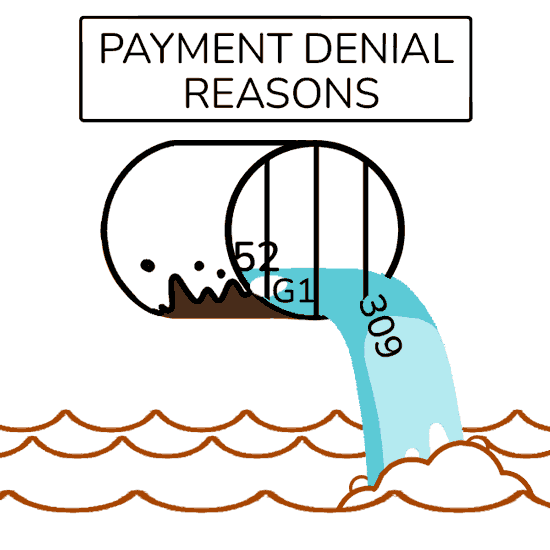Who's Failing e-Billing? Introducing Payer EDI Grades

For workers’ comp electronic billing (e-billing) to function, payers (also known as claims administrators) must do their part.
To hold them accountable, daisyBill now publicly grades claims administrators based on how well they accept and respond to e-bills for workers’ comp treatment.
Every day, our 7,400 provider clients use daisyBill to submit bills to over 900 claims administrators. The result: daisyData, our constantly updated, real-world billing dataset representing all submissions made in the last 365 days.
Using this massive dataset, we now assign each claims administrator an Electronic Data Interchange (EDI) Grade that reflects their e-billing performance. Each administrator’s EDI Grade, ranked from A+ to F, is displayed in our Claims Administrator and Network Directory.
When a claims administrator botches e-bill handling, the fallout lands squarely on practices. Delayed payments, rejected bills, and endless phone calls and follow-ups make it harder for providers to treat injured workers.
Read on for the full breakdown of how we grade claims administrators, and why it matters for every stakeholder in the system.
Claims Administrator & Network Directory: EDI Snapshot
As shown below, the Claims Administrator Directory page now features an ‘EDI Grade’ for each claims administrator in our system, along with other at-a-glance information like the average number of days it takes them to pay our clients.
Visitors can sort claims administrators by EDI Grade to get a quick snapshot of which claims administrators most consistently measure up (and which consistently fail providers nationwide).
The billing data we use to calculate EDI Grades is updated daily.
Making the Grade: How daisyBill Evaluates EDI Performance
To assign each EDI Grade, daisyBill tracks four essential components of e-billing performance for every claims administrator in our system.
These EDI components are weighted differently because not all e-bill failures create the same level of burden for providers; we assign more weight to EDI failures that cause the most administrative hassle.
For example, accepting e-bills is a bare-minimum expectation (and a legal requirement in many states), so we assign the ‘837 Sent’ category a weight of 15%. By contrast, failure to send electronic Explanations of Review (e-EORs) forces practice staff to spend hours manually entering payment information. Accordingly, the ‘835 Posted’ component accounts for 75% of the overall EDI grade.
The table below shows the complete breakdown of how we calculate EDI Grades.
EDI Component |
Weight |
Description |
837 Sent (e-Bill) |
15% |
The volume and percentage of e-bills (aka 837 files) providers send to the claims administrator, indicating the claims administrator’s ability to accept e-bills. |
277 Timely Receipt |
5% |
How consistently the claims administrator sends providers electronic “receipts” (aka 277 files) acknowledging that the claims administrator successfully received each e-bill. |
277 Accept/Reject |
5% |
How often the claims administrator accepts providers’ e-bills for processing or improperly rejects e-bills. |
835 Posted (EOR/EOB) |
75% |
How consistently the claims administrator returns electronic Explanations of Review/Benefits (aka 835 files), which automatically post payment details to the provider’s e-billing system. |
Examples: CA State Fund vs Sedgwick
Above is the grade table for California’s State Compensation Insurance Fund (CA State Fund), a non-profit insurer. CA State Fund consistently delivers, accepting 100% of providers’ e-bills statistically and delivering 277s and e-EORs for almost every e-bill.
Overall, CA State Fund gets a 98% EDI Grade for handling e-bills: an A+ performance.
By contrast, there’s our old pal Sedgwick Claims Management Services, Inc., a TPA that, thanks to its sheer size and abysmal EDI management, has perhaps the biggest negative impact on workers’ comp providers nationwide.
Below, we can see that Sedgwick does very well in accepting e-bills and sending 277s. But remember: the most heavily weighted component is sending e-EORs, since that has the most significant administrative impact on providers.
As daisyNews has documented extensively (and reported to state authorities repeatedly), Sedgwick is terrible at remitting e-EORs, earning itself an ‘F’ in that category. As the nation’s largest workers’ comp claims administrator, Sedgwick’s e-EOR failures are a massive burden on providers and a huge detriment to the workers’ comp system.
Hence, the TPA’s overall ‘D’ grade.
Monitoring and publicizing claims administrator EDI performance is critical to ensuring a fair, efficient workers’ comp billing and payment system in which doctors want to participate.
For the sake of injured workers and the providers who treat them, daisyBill will keep this data publicly available to all stakeholders at no cost.
Know the status of every bill in the payment cycle, instantly. Click below to see how daisyBill changes the game.
BILL BETTER
DaisyBill provides content as an insightful service to its readers and clients. It does not offer legal advice and cannot guarantee the accuracy or suitability of its content for a particular purpose.






.png)